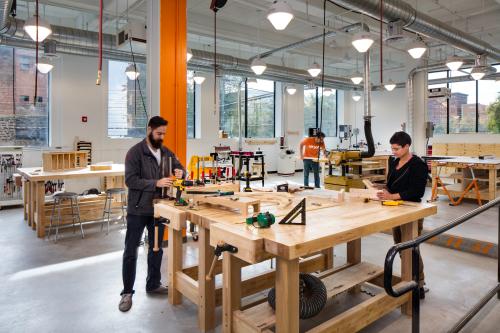Placemaking Postcards is a blog series from the Bass Center for Transformative Placemaking at Brookings where policymakers and practitioners guest-author promising placemaking efforts from across the U.S. and abroad that foster connected, vibrant, and inclusive communities. In line with the principle tenets of placemaking, the goal of the series is to recognize the community as the expert, highlight voices from the field, and to create a community of learning and practice around transformative placemaking.
 A lot has been written about our nation’s housing affordability crisis, and for good reason. Housing affordability is getting worse across the country, as costs continue to rise for middle- and low-income families alike. Stories abound on the impact on workers, especially our country’s teachers—bringing much-needed attention to an unfortunate reality: Too many teachers can’t afford to live where they teach.
A lot has been written about our nation’s housing affordability crisis, and for good reason. Housing affordability is getting worse across the country, as costs continue to rise for middle- and low-income families alike. Stories abound on the impact on workers, especially our country’s teachers—bringing much-needed attention to an unfortunate reality: Too many teachers can’t afford to live where they teach.
In 2009, RBH Group envisioned a solution to this problem: A mixed-use development in Newark, N.J. where educators could afford to live comfortably near their work, and where schools—rather than offices—would serve as the anchor tenant. Almost 10 years and a lot of hard work later, this vision has become a reality. We opened Teachers Village incrementally between 2013 and 2018, with 203 units of affordable, workforce rental housing marketed to educators. Alongside are three schools, an early childhood learning center, and 14 retail stores owned by local entrepreneurs.
Much could be said about the pathway and pitfalls to getting there, and indeed, we’ve received recognition for our efforts to provide affordable housing to teachers. But less is known about an equally important aspect of Teachers Village: our mission to support local entrepreneurs and build an ecosystem that directly benefits Newark residents and business owners. This, to our surprise, was the trickiest part.
The difficult path for local retail in downtown developments
While affordable housing is a crucial aspect of our development strategy, we also sought to create a community of small business owners, entrepreneurs, and residents that could facilitate a vibrant, locally serving economy. Downtown developers in other cities have secured higher rents by attracting big box stores, franchises, or outlets, but RBH pursued a retail strategy explicitly attracting local entrepreneurial tenants. That could mean small businesses with only one store or restaurant in the metro area, or first-time business owners who wanted to realize their dream of bringing delicious cupcakes or creative fitness regimens to their downtown neighbors.
This wasn’t a simple mission. In our first three years (from 2012 to 2015), only five retailers successfully inked a lease, built out their space, and consistently paid rent. The startup costs—design, permitting, construction, and more—proved too much for most tenants. We tried to help by offering a grace period of reduced or deferred rent, but it wasn’t enough to ease the burden.
Public and private programs designed to assist small businesses didn’t offer adequate products to support this “missing middle”—small businesses requiring more than a $10,000 loan and less than a $1 million loan. We assisted over a dozen local entrepreneurs in filling out paperwork for various economic incentive programs—including the Small Business Administration (SBA) loan program, a Community Development Entity (CDE) loan pool, and loan programs offered by nonprofits, universities, and local economic development authorities—all without success. Applicants either lacked adequate collateral (house, bank account balance) or the loans weren’t large enough to cover the costs of building out and furnishing the space.
At the end of the day, the time and effort required for presentations, meetings, and paperwork distracted from the retailers’ goal of serving customers and creating great places downtown. We knew there had to be a different strategy, and so we looked for ways to step in where other supports were lacking.
How downtown developers can support small businesses
Rather than getting discouraged by the unsteady path to financing and sustaining retailers, RBH’s retail brokers continued searching for a diverse mix of entrepreneurs with local knowledge, connections to the community, and a lot of drive.
After three years of setbacks, in 2015, RBH decided to raise additional financing to complete the retail construction ourselves, in order to help ease the affordability burden for aspiring tenants. We used our equity and New Markets Tax Credit funds to invest approximately $100 to $150 per square foot in the completion of the retail spaces, and worked with our in-house architectural, financial, and construction management personnel to assist store owners with their visions for the spaces.
Through these investments, an additional nine retailers signed leases in Teachers Village, including a curated wine tasting bar, a children’s dentist, a kids’ dance school, and a fitness studio offering classes to residents and students in Village schools. Of our 14 total stores, nine are currently occupied, and five more have signed leases. Newark-based entrepreneurs operate 44% of the stores, 57% are women-owned, 64% are minority-owned, and 43% are minority- and women-owned.
More important than filling the retail space is ensuring that it reflects the diversity, strength, and qualities of the Newark community. Our efforts have provided a blueprint on how we support local small businesses, particularly as we take the Teachers Village model to other cities across the country, including Hartford, Conn., Chicago, Atlanta, and Miami. With the right community partners at the table, we are finding success in advancing a more holistic approach to development.
Scaling solutions in an ever-changing economy
A decade after RBH commenced the Teachers Village project, the schools and residences there are fully occupied, with a waiting list for apartments. A true community is forming among the entrepreneurs, some of whom also chose to live in Teachers Village and send their kids to its schools. Our successes here have enabled us to scale this approach nationwide.
Our country is facing an affordability crisis affecting housing, small business prospects, and communities’ overall well-being. But within this crisis lies opportunity for innovative solutions. The conversation around affordable housing is shifting, as more communities support mixed-use developments with a greater range of affordability. Trends are shifting for businesses too: Despite fears of e-commerce overtaking traditional retail shopping, there remains a strong desire for variety, uniqueness, and local relevance in downtown retail. Consumers want to shop at a creative mix of stores, engage with knowledgeable shop-owners, and support local entrepreneurs at the same time.
To make an impact in this ever-changing economy, developers and community development financing institutions must recognize these trends, listen to what local communities, businesses, and consumers want, and allocate funding to support their aspirations. Our cities depend on it.
The Brookings Institution is committed to quality, independence, and impact.
We are supported by a diverse array of funders. In line with our values and policies, each Brookings publication represents the sole views of its author(s).







Commentary
How Newark, N.J.’s Teachers Village is building a community around education, affordability, and small business development
February 26, 2020